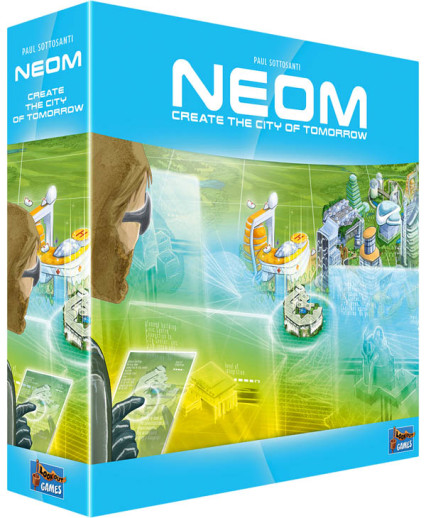We use cookies to make your experience better. To comply with the new e-Privacy directive, we need to ask for your consent to set the cookies. Learn more.
Neom: Create the City of Tomorrow Game
- Small parts. Not for children under 3 years.
A highly diverse game with loads of ways to win, Neom is a gaming nerd's dream for those who crave variety. Players independently plan and construct cities on starting grids, each of which produces a certain resource. Players begin by selecting 3 cornerstone tiles – these are special buildings which will score a number of points at the end of the game if the conditions specified on the tile are met. For instance, a cornerstone tile may give you points for how many of a certain kind of building are in your city or whether your roads are laid out in squares. Cornerstone tiles allow players to begin with a plan in mind for building their city, if they so choose – but even if players ignore their cornerstone tiles, they can employ a number of other strategies to win. They can build resource production buildings and eventually make luxury goods, build large connected residential neighborhoods, build commercial buildings that generate a lot of income, and build public office buildings which grant money or victory points based on other building types or placement. All of these constructions can net a player substantial points in the end. With 150 different tiles, each one a unique building with different point values/effects, there's a HUGE amount of variety in this game. But it's not just “build n' play" – careful thinking must be employed to maximize city effectiveness and prevent loss. For instance, tiles cannot be turned or manipulated, yet roads must somehow connect to the city center. Players can throw each other's games into disarray with disasters such as robberies and fires. And, planners of cities must be careful with constraints – points are lost for placing polluting production buildings near residences, leaving ghost towns, or not having enough power sources in the city – and if they don't produce enough resources or have enough money, they'll be limited in their building options. The game is played in three generations, each generation consisting of rotating hands of 8 tiles which players take turns picking and placing, then passing on. The player at the end of the third generation who scores the most victory points wins the game. For 1-5 players, with a game time of about 45 minutes. Game includes 150 building tiles (30 cornerstone tiles, 40 each of 1st, 2nd, and 3rd generation tiles), 65 coin tokens, 6 city boards, 85 goods/resource tokens, 1 scoring pad, and instructions for play. ~ Janine
| Product Format: | Other |
|---|---|
| Brand: | Lookout Games |
| Grades: | 4-AD |
| EAN/UPC: | 4260402316000 |
| Length in Inches: | 11.625 |
| Width in Inches: | 11.625 |
| Height in Inches: | 2.875 |
| Weight in Pounds: | 4.6 |

